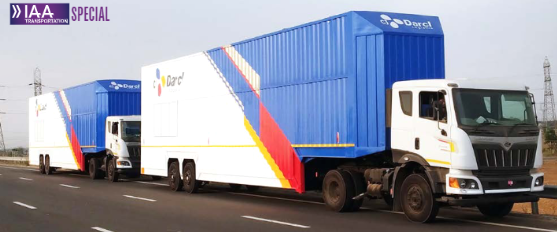-By Nikhil Agarwal, President, CJ Darcl Logistics

The development in logistics in India has been revolutionary in its true essence. This progress is shown by the upgrade in the country’s position on the LPI from 54th place in 2014 to 38th place in 2023. The PHDCCI (PHD Chamber of Commerce and Industry of India) claims that the country is likely to be ranked amongst the top five global logistics leaders in the year 2047 due to distinctive strategies being implemented in the logistics domain in India. The current status of the Indian freight and logistics market has revealed tremendous growth.
The Indian freight and logistics market has grown remarkably over the past decade. With a projected growth trajectory of $484.43 billion by 2029, the sector, currently valued at $317.26 billion, plays a crucial role in the economy and employs over 20 million people. This growth is driven by extensive adoption of technological advancements, enhancing efficiency and productivity along with government initiatives.
Government Initiatives and Infrastructure Development
In 2021, the government unveiled the PM Gati Shakti National Master Plan (NMP) for improving connectivity infrastructure throughout different economic areas. This inclusive plan entails documenting several essential facilities from the current and expected ongoing projects in various ministries and departments. The PM-Gati Shakti and the National Logistics Policy (NLP) laid the foundation for a Data-Driven Decision Support System (DDS) that would enhance the effectiveness and lower logistics costs.

There is an added focus on the transport sector where the National Infrastructure Pipeline (NIP) suggests projects worth ₹69 lakh crore. These initiatives have been embarked on roads and highways, railway systems, and urban public systems transport. The Indian transport and logistics industry is expected to expand at a Compound Annual Growth Rate (CAGR) of nearly 4 percent. This synergizes with the government’s vision to develop and upgrade transport infrastructure in the country through the expansion of port access, development of green-field airports, and construction of expressways.
Sustainability and Green Growth
Sustainability is another field developed in the NIP, where the infrastructure’s sustainability, green energy initiatives, and environmentally friendly mobility solutions are encouraged. The NIP seeks to assist clients and local communities to achieve sustainable development goals by incorporating sustainability principles into the projects, thus ensuring that there are long-lasting gains economically, fewer adverse effects on the environment, and better preparedness for shocks resulting from climate change. Since transport is responsible for 14% of greenhouse gas emissions, efficient practices must be employed to address climate objectives. One such area that has witnessed India’s strong intent is towards Sustainable Transport through EVs, and cleaner fuels and technologies. It is expected that the market will have a demand for at least one million charging stations by the year 2030 given the exponential market growth in the EV industry. Integrated solar-powered charging stations and sustainable and environmentally friendly Dedicated Freight Corridors (DFCs) fitted solar panels underscore India’s commitment to sustainability in the transportation industry. Smart technologies like smart materials and digital twins work hand in hand with digitalization projects to pave the way for a smarter and more efficient EV industry.
Enhancing Connectivity and Competitiveness
The improvement and expansion of linkages with economic and industrial clusters through multimodal connectivity, encouraging the use of domestic materials, and increasing the competitiveness of the nation can be attributed to the roles based on the government’s plans to turn India into a developed country by 2047. These endeavors will also enhance the logistics operations of the EXIM hence fortifying the process of international business and development of the Indian nation towards the achievement of its developmental strides.
Technological Integration
Technological developments are essential for improving the effectiveness and environmental impact of transport. Mobility is being revolutionized by Smart technologies such as vehicle-to-grid or V2G, Internet of Things/ IoT, Artificial Intelligence/ AI, and Big Data. AI software assisted by IoT contributes to the smart charging time of the electric vehicle by monitoring the charging process to increase the efficiency and satisfaction level of the users. Also, innovations such as MaaS – Mobility as a Service and MoD – Mobility on Demand are the new approaches to urban transport that are environmentally friendly.
Skilling and Empowering the Workforce
To accomplish the dream of Viksit Bharat by 2047 enforces the correlation between India’s employed working class and the emerging potential of fourth industrial revolution technology. Thus, having the majority of the blue-collar workers with 85% of the total workforce, the requirement to skill and upgrade the skills of over 400 million workers is needed by 2030 for the requirements of the new economy.
It is crucial to have localized solutions that would target blue-collar workers’ needs, including investment in rural areas, access to the internet, digital literacy programs, and AI technology. Successfully overcoming the digital divide is crucial for the development of the nation.
Conclusion
Through the growth model, Sustainable green growth and utilization of technology for the betterment of people is the roadmap to India’s economic growth. Measures such as the Make in India and the Production Linked Incentive (PLI) scheme are materializing. Public service delivery has gone a generation ahead through digital public service delivery infrastructure.
The interim budget 2024-25 further asserted the government’s intent to continue its focus on infrastructure development, affordable housing, Green Energy, education/research and development, and digital infrastructure. Focus on these areas is necessary to build a sustainable growth model that will help India attain the ambitious goal of a $ 5 trillion economy in the coming 3 years. This path to achieving ‘Viksit Bharat’ involves contribution from the government, private sectors, and the contribution from the working population as we strive towards bringing about development and sustainability in India.